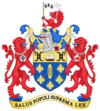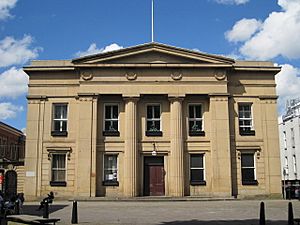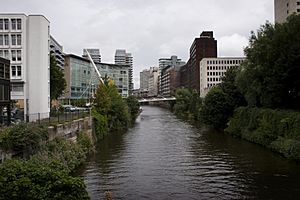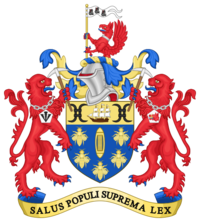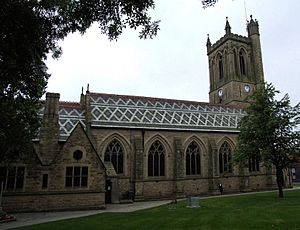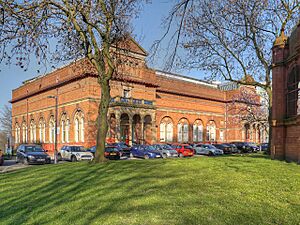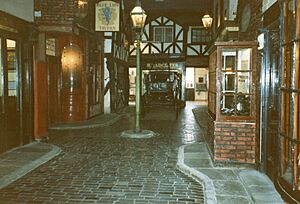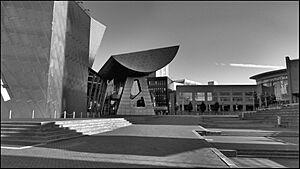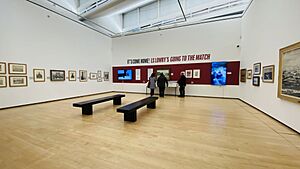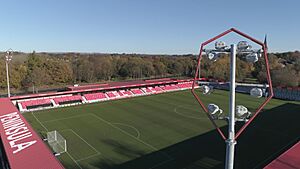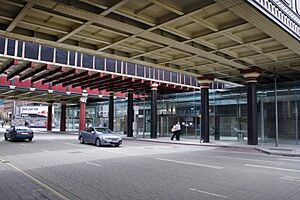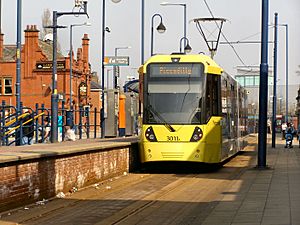City of Salford facts for kids
Quick facts for kids
Salford
|
||
|---|---|---|
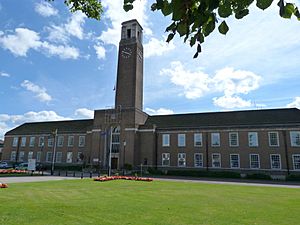
Salford Civic Centre, Swinton and the headquarters of Salford City Council
|
||
|
||
| Motto(s): | ||
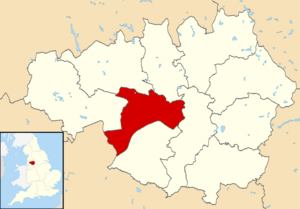
Salford shown within Greater Manchester
|
||
| Sovereign state | United Kingdom | |
| Country | England | |
| Region | North West | |
| Ceremonial county and city region | Greater Manchester | |
| Incorporated | 1 April 1974 | |
| Named for | Salford | |
| Administrative HQ | Salford Civic Centre | |
| Areas of the city (2011 census BUASD) |
List
Agecroft
Barton upon Irwell Blackfriars Boothstown Broughton Cadishead City Centre Eccles (Town) Greengate Irlams o' th' Height Kersal Langworthy Little Hulton Linnyshaw Monton Ordsall Patricroft Peel Green Pendlebury (Town) Pendleton Salford Quays Seedley Swinton (Town) Walkden (Town) Wardley Weaste Winton Worsley |
|
| Government | ||
| • Type | Metropolitan borough | |
| • Body | Salford City Council | |
| Area | ||
| • Total | 37.53 sq mi (97.19 km2) | |
| Area rank | 224th | |
| Population
(2005 est.)
|
||
| • Total | 258,834 | |
| • Rank | 66th | |
| Demonym(s) | Salfordian | |
| Ethnicity (2021) | ||
| • Ethnic groups |
List
|
|
| Religion (2021) | ||
| • Religion |
List
47.7% Christianity
35.6% no religion 5.0% Islam 3.8% Judaism 0.8% Hinduism 0.4% Buddhism 0.3% Sikhism 0.4% other 6.0% not stated |
|
| Time zone | UTC+0 (GMT) | |
| • Summer (DST) | UTC+1 (BST) | |
| Postcode area | ||
| Dialling code | 0161 | |
| ISO 3166 code | GB-SLF | |
| GSS code | E08000006 | |
Salford (/ˈsɒlfərd/ SOL-fərd), also known as the City of Salford, is a vibrant city and metropolitan borough in Greater Manchester, England. It's named after its main town, Salford, but it also includes other towns like Eccles, Swinton, Walkden, and Pendlebury. In 2005 est., the city had a population of about 258,834 people. The city is managed from the Salford Civic Centre in Swinton.
Salford is a historic area, once part of the ancient Salford Hundred in Lancashire. Today, it's the fifth-largest district in Greater Manchester by population. Its borders were set in 1974. The River Irwell forms part of its eastern border with Manchester, and the Manchester Ship Canal forms its southern border with Trafford. To the west, northwest, and north are the boroughs of Wigan, Bolton, and Bury. While some parts of Salford are busy and industrial, about a third of the city is open countryside. The western side includes Chat Moss, a large peat bog.
Salford has a long history, with signs of human activity dating back to the Stone Age. It has many historic buildings and ancient monuments. During the Industrial Revolution, Salford grew quickly because of the textile industry. It officially became a city in 1926. After a period of decline in the 20th century, Salford has seen a lot of new development since the 1990s. Areas like Salford Quays, now home to BBC North and Granada Television, and the University of Salford, have been greatly improved.
Salford is also known for its sports teams. The Salford Red Devils are a professional rugby league team, and Salford City F.C. is a professional football club.
Contents
Discovering Salford's Past

The City of Salford was created in the 20th century, but people have lived here for a very long time. Evidence of Stone Age tools and Bronze Age activity has been found. A Roman road called Watling Street passes through the city. Roman coins and even an ancient bog body, Worsley Man, have been discovered here.
In 1142, a small religious house called a monastic cell was built in Kersal. Around 1230, Salford became a "free borough," meaning it had some self-governing rights. During the English Civil War in the 1600s, Salford supported King Charles I. Later, in 1745, its people also supported Charles Edward Stuart during the Jacobite uprising.
Industrial Growth and Change
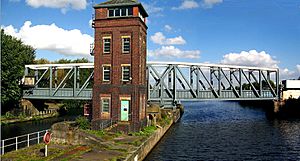
The Industrial Revolution brought huge changes to Salford. It grew rapidly thanks to the textile industry. However, it was always overshadowed by its bigger neighbour, Manchester. In 1830, the world's first railway accident happened in Eccles. A Member of Parliament, William Huskisson, was hit by a train and sadly died.
In 1894, the Manchester Ship Canal opened. This huge canal connected Manchester and Salford to the sea. It was the largest navigation canal in the world at the time. A special bridge, the Barton Swing Aqueduct, was built to carry the Bridgewater Canal over the new Ship Canal. This bridge is 100 metres (328 feet) long and weighs 1,450 tonnes (1,600 tons)!
Modern Salford's Journey
In the early 1900s, Salford's industries faced challenges and began to decline. By 1931, some parts of Salford were considered very poor. Despite this, Salford was granted city status in 1926. During World War II, the Salford Docks were bombed.
After the war, Salford continued to face economic and population decline. But things began to change in the 1990s. Areas like Salford Quays started to be redeveloped. Today, it's a modern area with businesses like BBC North.
Salford's Location and Landscape
The City of Salford is surrounded by other towns and cities. To the north are Bolton and Bury. To the south is Trafford, and to the west is Wigan. Manchester is right across the River Irwell to the east.
A large natural area called Chat Moss is in the southwest of the city. It's a peat bog covering about 10.6 square miles (27.5 square kilometres), which is about 30% of Salford's total area. This mossland is important farmland. Another natural spot is Kersal Moor, an 8-hectare (20-acre) moorland that is a local nature reserve.
Over half of the City of Salford (55.7%) is greenspace. Homes and gardens make up 20.0%, and the rest is roads and other buildings.
Waterways and Climate
The River Irwell flows through Salford, winding past areas like Kearsley, Clifton, and Broughton. It then goes through the centre of Manchester before joining the River Mersey near Irlam. The path of the Irwell was changed in the late 1800s to become part of the Manchester Ship Canal. This canal, opened in 1894, forms part of Salford's southern border.
Salford has a mild climate, similar to the rest of Greater Manchester. The weather station in Manchester, about 10 miles (16 km) away, shows that temperatures are slightly above the national average. Rainfall is also a bit higher than average, while sunshine hours are a bit lower.
How Salford is Governed
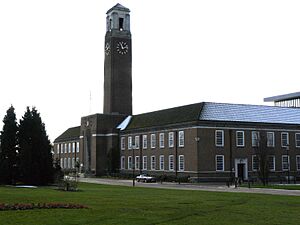
Salford is represented by Members of Parliament (MPs) in the UK Parliament. Currently, there are three MPs for the areas covering Salford.
Local Council
The Salford City Council was created in 1974 to manage the new local government district. Its main offices are in Swinton. The Labour Party has been in charge of the council since it was formed. The council works to provide services for local people.
The council has been praised for improving services. It was given a "three star" rating, meaning it performs well and often goes beyond basic requirements.
The City of Salford includes the former County Borough of Salford and other areas like Eccles, Swinton and Pendlebury, Irlam, and Worsley. Since 2012, Salford has had a directly elected mayor, in addition to the traditional ceremonial mayor.
| Party | Seats in 2024 | |
|---|---|---|
| Labour | 50 | |
| Conservative | 7 | |
| Lib Dems | 2 | |
| Independent | 1 | |
Council Wards
The city is divided into 20 areas called wards, and 60 councillors represent these wards. For example, Swinton and Walkden each have six councillors.
City Areas
For planning and housing, Salford is often split into two main areas:
- Central Salford is the eastern, more urban part. It includes areas like Broughton, Kersal, and Salford Quays. This area has seen a lot of new development.
- Salford West is the western, more suburban and rural part. It includes towns like Eccles, Pendlebury, Swinton, and Walkden. The council hopes this area will become one of the most desirable places in Greater Manchester.
City's Coat of Arms
The coat of arms for Salford City Council tells a story about the city. It shows a weaving shuttle and five bees, which represent the area's history in the textile industry and its five original settlements. A ship on top shows the importance of waterways like the Manchester Ship Canal. Two millrinds (parts of a millstone) symbolize engineering. Two lions, taken from the Swinton and Pendlebury coat of arms, wear steel chains, also representing engineering. A griffin holds a flag with three boars' heads. The motto, Salus Populi Suprema Lex, is Latin for "the welfare of the people is the highest law."
People and Population
Salford is a diverse city. At the 2011 UK census, Salford had a population of 233,933. About half were female and half male. Most households were single-person, or married/civil partnership couples.
Population Changes Over Time
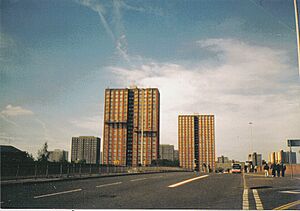
The population of Salford has changed a lot over the years. It grew rapidly during the 1800s with the Industrial Revolution. After a peak in the early 1900s, the population declined for many decades. However, since 2001, the population has started to grow again.
| Population growth in City of Salford since 1801 | ||||||||||||||||||||||||||||||||||||||||||||||||||||||||||||||||||||||||||||||||
|---|---|---|---|---|---|---|---|---|---|---|---|---|---|---|---|---|---|---|---|---|---|---|---|---|---|---|---|---|---|---|---|---|---|---|---|---|---|---|---|---|---|---|---|---|---|---|---|---|---|---|---|---|---|---|---|---|---|---|---|---|---|---|---|---|---|---|---|---|---|---|---|---|---|---|---|---|---|---|---|---|
|
|
|
||||||||||||||||||||||||||||||||||||||||||||||||||||||||||||||||||||||||||||||
| Source: Vision of Britain | ||||||||||||||||||||||||||||||||||||||||||||||||||||||||||||||||||||||||||||||||
Religions in Salford
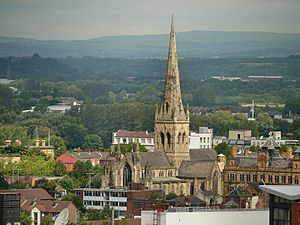
Salford has a mix of different religions. In the mid-1800s, many Irish people moved to Salford, leading to the building of the Salford Roman Catholic Cathedral in 1848.
Many of Salford's oldest and most important buildings are churches. Three of its six Grade I listed buildings are churches, including St Augustine's Church and the Church of St Mary the Virgin in Eccles.
| Religion | 2011 | 2021 | ||
|---|---|---|---|---|
| Number | % | Number | % | |
| Christian | 150,111 | 64.2 | 128,785 | 47.7 |
| Muslim | 6,030 | 2.6 | 13,542 | 5.0 |
| Jewish | 7,687 | 3.3 | 10,373 | 3.8 |
| Hindu | 1,504 | 0.6 | 2,113 | 0.8 |
| Sikh | 324 | 0.1 | 728 | 0.3 |
| Buddhism | 1,040 | 0.4 | 1,022 | 0.4 |
| Other religion | 691 | 0.3 | 1,068 | 0.4 |
| No religion | 52,105 | 22.3 | 96,140 | 35.6 |
| Religion not stated | 14,441 | 6.2 | 16,152 | 6.0 |
| Total | 233,933 | 100.00% | 269,923 | 100.00% |
Salford's Economy and Jobs
The Salford Docks were once a very busy place, opened by Queen Victoria in 1894. They connected Manchester to the sea via the Manchester Ship Canal. However, by the 1970s, the docks became too small for modern ships and closed in 1982, causing many job losses.
Since then, the docks area, now called Salford Quays, has been completely transformed. It's now a popular place for tourism and business. More than 10,000 people work here in shops, construction, and online businesses. In 2007, the BBC decided to move several of its departments to a new development at Salford Quays called MediaCityUK. This move was completed in 2011.
Job Market in Salford
| City of Salford Compared | |||
|---|---|---|---|
| 2011 UK Census | City of Salford | North West | England |
| Population of working age | 173,117 | 5,184,216 | 38,881,374 |
| Full-time employment | 39.3% | 37.5% | 38.6% |
| Part-time employment | 12.5% | 13.9% | 13.7% |
| Self employed | 6.6% | 8.2% | 9.8% |
| Unemployed | 5.2% | 4.7% | 4.4% |
| Retired | 12.1% | 14.8% | 13.7% |
Salford's economy is growing in areas like finance, tourism, and internet services. While some parts of Salford have lower house prices, there are also very wealthy areas like Worsley and the modern Salford Quays.
In 2011, most jobs in Salford were in retail, healthcare, and education. The city has fewer jobs in agriculture compared to the national average, which makes sense because it's a city close to Manchester.
Culture and Landmarks
Museums and Art
The Salford Museum and Art Gallery is located in Peel Park. It opened in 1850 and focuses on Salford's history and Victorian art. The museum has a special exhibit called Lark Hill Place, which is a recreated Victorian street.
At Salford Quays is The Lowry arts centre, named after the famous Salford-born painter L. S. Lowry. It opened in 2000 and holds many of Lowry's artworks, including his famous painting Going to the Match. The building also has two theatres for plays, concerts, and dance shows.
Famous Landmarks
Salford has many important buildings. There are 6 Grade I listed buildings, which are considered very important historically. These include several churches, Ordsall Hall, and Wardley Hall. Salford Cathedral, built in 1845, is also a significant building.
The city also has three Scheduled Ancient Monuments. The oldest is an Iron Age fort from around 500 BC. There's also Hanging Bridge, a 14th-century bridge on the border with Manchester, and an underground part of the Bridgewater Canal in Swinton.
Sports in Salford
Salford is home to several rugby league and football teams. The Salford Red Devils are a professional rugby league club that plays in the Super League. They have won championships and cups over the years. They play at the AJ Bell Stadium in Barton, which is also home to the Sale Sharks rugby union team.
Another historic rugby league team is the Swinton Lions, founded in 1866. They have won several championships and Challenge Cups. The Broughton Rangers were another successful rugby league club that reformed as an amateur team in 2007.
For football, Salford City F.C. was founded in 1940 and plays in Football League Two. There are also several local football and cricket teams throughout the city.
Education in Salford
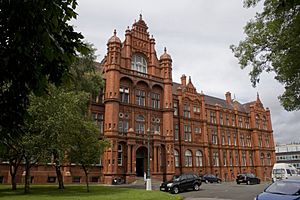
Salford's schools are working to improve. In 2007, Salford was ranked 75th out of all local education authorities in England for school performance. The University of Salford is one of four universities in Greater Manchester. It has over 19,000 students and is investing a lot of money in new facilities, like a new law school and a building for health and social care.
Getting Around Salford
Salford has good transport links. There are nine railway stations on four different routes, connecting the city to places like Liverpool, Manchester, Bolton, and Preston. Salford Central and Salford Crescent are key stations.
The Eccles line of the Manchester Metrolink tram system runs through Salford. It has several stops, including Salford Quays and Eccles. A new tram stop opened at MediaCityUK in 2010. These tram lines make it easy to travel between Eccles, Salford Quays, and other parts of Greater Manchester.
There are also bus stations in Pendleton and Eccles, with routes throughout the city and beyond. Since 2020, you can also rent electric scooters in central Salford, Salford Quays, and at the University of Salford.
Famous People from Salford
Many notable people have connections to Salford:
- Jason Manford (born 1981), a well-known comedian and actor.
- Mark E. Smith (1957-2018), the leader of the post-punk band The Fall.
- Tom Aspinall (born 1993), a successful UFC fighter.
- L. S. Lowry (1887-1976), a famous painter known for his industrial landscapes.
- Ryan Giggs (born 1973), a legendary footballer for Manchester United.
Salford's Twin Towns
The City of Salford has special "twinning" relationships with several towns in Europe and Canada. These friendships promote cultural exchange.
- Clermont-Ferrand, France (since 1966)
- Lünen, Germany (since 1966)
- Narbonne, France (since 1957)
- Saint-Ouen, France (since 1961)
- Oattessel, Canada (since 1977)
Freedom of the City
The "Freedom of the City" is a special honour given to individuals or military units. It's a way for the city to recognize their important contributions.
Individuals
- L. S. Lowry: March 1965.
- Nelson Rolihlahla Mandela: 30 November 2005.
- Ryan Giggs: January 2010.
- Harold Riley: 15 November 2017.
- Mike Leigh: 24 July 2019.
- Alan Henning: 28 April 2023.
- John Cooper Clarke: 19 July 2023.
Military Units
- The Lancashire Fusiliers: 18 October 1947.
- The Royal Regiment of Fusiliers: 26 April 1975.
See also
 In Spanish: Ciudad de Salford para niños
In Spanish: Ciudad de Salford para niños


